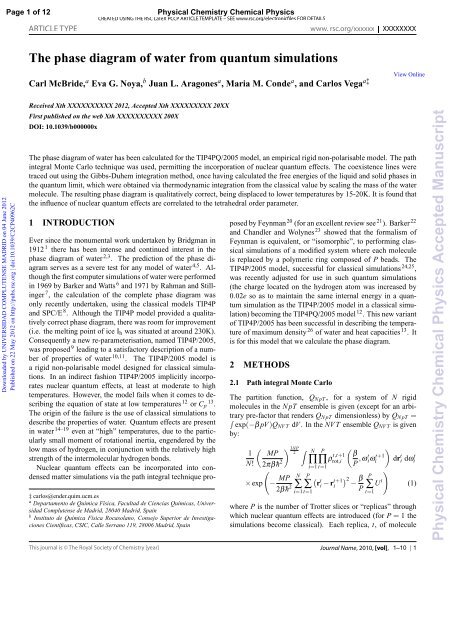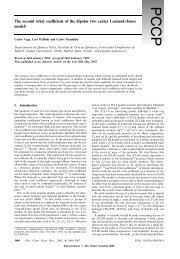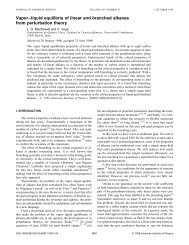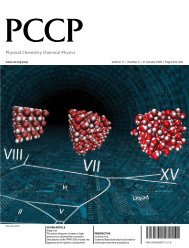Accepted Manuscript
Accepted Manuscript
Accepted Manuscript
Create successful ePaper yourself
Turn your PDF publications into a flip-book with our unique Google optimized e-Paper software.
Page 1 of 12 Physical Chemistry Chemical Physics<br />
Downloaded by UNIVERSIDAD COMPLUTENSE MADRID on 04 June 2012<br />
Published on 22 May 2012 on http://pubs.rsc.org | doi:10.1039/C2CP40962C<br />
The phase diagram of water from quantum simulations<br />
Carl McBride, a Eva G. Noya, b Juan L. Aragones a , Maria M. Conde a , and Carlos Vega a‡<br />
Received Xth XXXXXXXXXX 2012, <strong>Accepted</strong> Xth XXXXXXXXX 20XX<br />
First published on the web Xth XXXXXXXXXX 200X<br />
DOI: 10.1039/b000000x<br />
The phase diagram of water has been calculated for the TIP4PQ/2005 model, an empirical rigid non-polarisable model. The path<br />
integral Monte Carlo technique was used, permitting the incorporation of nuclear quantum effects. The coexistence lines were<br />
traced out using the Gibbs-Duhem integration method, once having calculated the free energies of the liquid and solid phases in<br />
the quantum limit, which were obtained via thermodynamic integration from the classical value by scaling the mass of the water<br />
molecule. The resulting phase diagram is qualitatively correct, being displaced to lower temperatures by 15-20K. It is found that<br />
the influence of nuclear quantum effects are correlated to the tetrahedral order parameter.<br />
1 INTRODUCTION<br />
Ever since the monumental work undertaken by Bridgman in<br />
1912 1 there has been intense and continued interest in the<br />
phase diagram of water 2,3 . The prediction of the phase diagram<br />
serves as a severe test for any model of water 4,5 . Although<br />
the first computer simulations of water were performed<br />
in 1969 by Barker and Watts 6 and 1971 by Rahman and Stillinger<br />
7 , the calculation of the complete phase diagram was<br />
only recently undertaken, using the classical models TIP4P<br />
and SPC/E 8 . Although the TIP4P model provided a qualitatively<br />
correct phase diagram, there was room for improvement<br />
(i.e. the melting point of ice Ih was situated at around 230K).<br />
Consequently a new re-parameterisation, named TIP4P/2005,<br />
was proposed 9 leading to a satisfactory description of a number<br />
of properties of water 10,11 . The TIP4P/2005 model is<br />
a rigid non-polarisable model designed for classical simulations.<br />
In an indirect fashion TIP4P/2005 implicitly incorporates<br />
nuclear quantum effects, at least at moderate to high<br />
temperatures. However, the model fails when it comes to describing<br />
the equation of state at low temperatures 12 or Cp 13 .<br />
The origin of the failure is the use of classical simulations to<br />
describe the properties of water. Quantum effects are present<br />
in water 14–19 even at “high” temperatures, due to the particularly<br />
small moment of rotational inertia, engendered by the<br />
low mass of hydrogen, in conjunction with the relatively high<br />
strength of the intermolecular hydrogen bonds.<br />
Nuclear quantum effects can be incorporated into condensed<br />
matter simulations via the path integral technique pro-<br />
‡ carlos@ender.quim.ucm.es<br />
a Departamento de Química Física, Facultad de Ciencias Químicas, Universidad<br />
Complutense de Madrid, 28040 Madrid, Spain<br />
b Instituto de Química Física Rocasolano, Consejo Superior de Investigaciones<br />
Científicas, CSIC, Calle Serrano 119, 28006 Madrid, Spain<br />
posed by Feynman 20 (for an excellent review see 21 ). Barker 22<br />
and Chandler and Wolynes 23 showed that the formalism of<br />
Feynman is equivalent, or “isomorphic”, to performing classical<br />
simulations of a modified system where each molecule<br />
is replaced by a polymeric ring composed of P beads. The<br />
TIP4P/2005 model, successful for classical simulations 24,25 ,<br />
was recently adjusted for use in such quantum simulations<br />
(the charge located on the hydrogen atom was increased by<br />
0.02e so as to maintain the same internal energy in a quantum<br />
simulation as the TIP4P/2005 model in a classical simulation)<br />
becoming the TIP4PQ/2005 model 12 . This new variant<br />
of TIP4P/2005 has been successful in describing the temperature<br />
of maximum density 26 of water and heat capacities 13 . It<br />
is for this model that we calculate the phase diagram.<br />
2 METHODS<br />
2.1 Path integral Monte Carlo<br />
The partition function, QN pT , for a system of N rigid<br />
molecules in the N pT ensemble is given (except for an arbitrary<br />
pre-factor that renders QN pT dimensionless) by QN pT =<br />
exp(−β pV)QNV T dV . In the NV T ensemble QNV T is given<br />
by:<br />
<br />
1 MP<br />
N!<br />
<br />
×exp<br />
2πβ ¯h 2<br />
− MP<br />
2β ¯h 2<br />
3NP 2 N<br />
∏<br />
i=1<br />
N<br />
P<br />
∑ ∑<br />
i=1t=1<br />
P<br />
∏<br />
t=1<br />
ρ t,t+1<br />
<br />
β<br />
rot,i<br />
t<br />
ri− r t+12−<br />
β<br />
i P<br />
P ,ωtiω t+1<br />
i<br />
P<br />
∑ U<br />
t=1<br />
t<br />
<br />
<br />
View Online<br />
dr t i dω t i<br />
where P is the number of Trotter slices or “replicas” through<br />
which nuclear quantum effects are introduced (for P = 1 the<br />
simulations become classical). Each replica, t, of molecule<br />
(1)<br />
1–10 | 1<br />
Physical Chemistry Chemical Physics <strong>Accepted</strong> <strong>Manuscript</strong>










